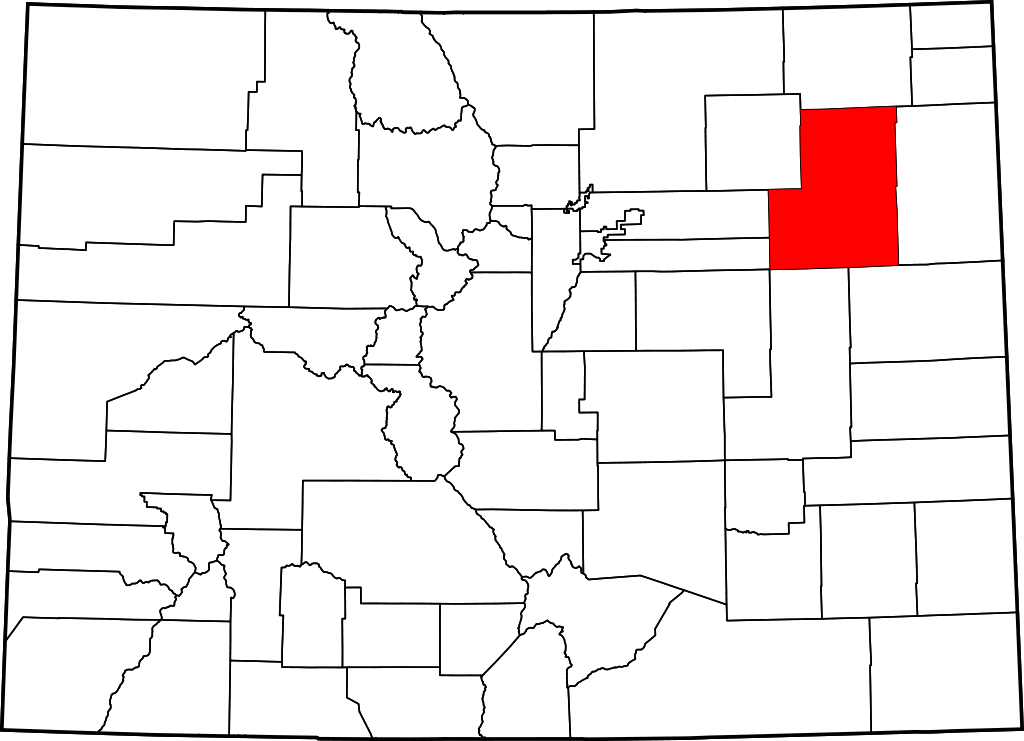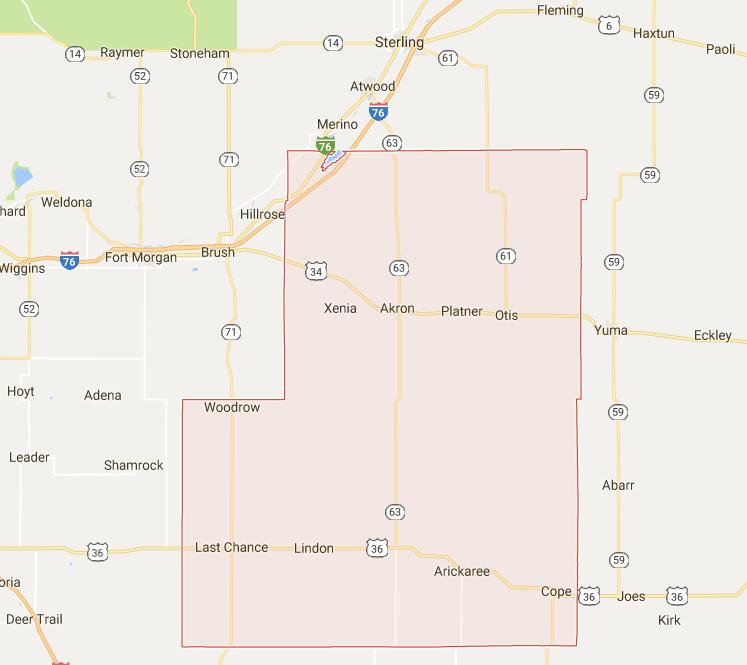Washington County
Full Article
Washington County, named for the first US president, is a county of 2,524 square miles on Colorado’s eastern Great Plains. It is bordered to the north by Logan County, to the east by Yuma County, to the south by Kit Carson and Lincoln Counties, and to the west by Arapahoe, Adams, and Morgan Counties.
Washington County was formed in 1887 when the state legislature broke up a larger Weld County. Washington then ceded its eastern half to the formation of Yuma County in 1889 and assumed its current size by acquiring part of eastern Arapahoe County in 1903. Today the county has a population of 4,864. Akron, with a population of 1,702, is the county seat. Otis, with a population of 534, is the only other incorporated area in Washington County, as most of its residents live on the county’s 824 farms.
US Highways 34 and 36 are the major east-west thoroughfares: Highway 34 runs through Akron and Otis in the northern part of the county, and Highway 36 runs through the small communities of Last Chance, Lindon, Anton, Arickaree, and Cope to the south. State Highway 63 bisects the county running north-south through Anton and Akron, while State Highway 71 (County Road G) meets US 36 at Last Chance, continuing north to Morgan County and south to Lincoln County. A portion of Interstate 76 runs through the northwestern corner of Washington County, near the small farm community of Messex.
Water resources include a number of small tributaries to the South Platte, but the county generally lacks the major water sources of its neighbors, such as the South Platte River in Morgan County or the Ogallala Aquifer underneath Yuma County. To cope with the county’s aridity, Washington County farmers have long relied on the cultivation of dryland crops, especially winter wheat, of which it is one of the state’s top producers.
Native Americans
From around AD 1000 to 1400, members of the Upper Republican and Itskari cultures occupied parts of northeast Colorado, including present-day Washington County. These semi-sedentary people fished, farmed, and hunted bison, living in earthen lodges and crafting distinctive ceramic pots. While they were apparently able to thrive in eastern Colorado for nearly three centuries, it appears that environmental pressures—most likely drought—caused them to gradually abandon the region. There is little evidence of their presence in the area by the mid-fifteenth century.
During the late eighteenth and early nineteenth centuries, the rapid expansion of the Lakota displaced a number of other nations from the northern plains, including the Arapaho, Cheyenne, and Kiowa. These groups filtered south onto the plains of Nebraska, Wyoming, and Colorado. The Pawnee also made occasional visits to eastern Colorado, although they mostly frequented present-day Kansas and Nebraska.
By 1790 the Kiowa had moved onto the plains from the mountains of Montana. The Cheyenne and Arapaho, meanwhile, had been migrating westward from their homelands in the upper Midwest since the early eighteenth century. By 1800 the Lakota had forced both the Cheyenne and Arapaho out of present-day South Dakota. The Cheyenne and Arapaho followed the buffalo herds across the plains, living in portable, cone-shaped dwellings called tipis. During the notoriously harsh plains winters, they found shelter near bluffs and in cottonwood groves along the river bottoms. While the Cheyenne rarely left the plains, the Arapaho made a habit of venturing into the mountains during the spring to hunt game in the high country.
Anglo-American traffic across the Colorado plains increased during the 1840s with the organization of the Oregon Territory and the California Gold Rush of 1849. In response to this incursion, Indigenous people sometimes harassed or stole from wagon trains, and many whites began to fear these attacks as they crossed the plains. In 1851 the federal government sought to make the westward journey safer for white travelers with the Treaty of Fort Laramie, signed by leaders of the Cheyenne, Lakota, Arapaho, and other Indigenous nations. The treaty acknowledged Native American sovereignty across the plains, and each group would receive annual payments in exchange for guaranteeing safe passage for whites and allowing the government to build forts in their territory.
Relations between Colorado’s Native Americans and the US government deteriorated after the Colorado Gold Rush in 1858–59, with the latter pursuing an agenda that sought to strip away Native Americans’ rights to the land. In 1861 the Treaty of Fort Wise relegated the Cheyenne and Arapaho to a small reservation in eastern Colorado between the Arkansas River and the Smoky Hill Trail. It was on that reservation, along Sand Creek in present-day Kiowa County, that Col. John Chivington and the Third Colorado Volunteers slaughtered some 150 peaceful Cheyenne and Arapaho—mostly women, children, and the elderly—in 1864.
Enraged by the massacre, groups of Cheyenne and Arapaho warriors, such as the Cheyenne Dog Soldiers, fought a bloody war of resistance against the US Army. The last major engagement of the so-called Indian Wars in Colorado occurred in 1869 at Summit Springs in present-day Washington County, where the Dog Soldier leader Tall Bull was killed. After 1867, with the exception of the Dog Soldiers, most of the remaining Cheyenne and Arapaho in the Washington County area had been relocated to Oklahoma per the Medicine Lodge Treaty.
County Development
With the exception of a few ranchers, in the 1870s the area that would become Washington County was uninhabited. In the early 1880s the Chicago, Burlington & Quincy Railroad (CB&Q) began building a line across the Colorado plains toward Denver, and land along the route became more valuable.
In 1882 A. B. Smith of the Lincoln Land Company, a subsidiary of the railroad, surveyed the current town site of Akron, and the town of Otis began as a railroad camp. With the exception of a store operated by Patrick Dougherty, the Akron town site remained empty until 1886, when the first additions were platted. Akron is the Greek word for “summit,” and in the context of the plains the name is appropriate, as the town sits at 4,669 feet, the highest point east of Denver.
Washington County was created the following year, split from a larger Weld County. Akron quickly became an important railroad depot, and by 1890 it featured not just a railroad roundhouse and depot but also a general store, two newspapers, four hotels, four blacksmiths, five doctors’ offices, a Presbyterian church, and a library.
In the early twentieth century, boosters in newly settled towns across Colorado published promotional pamphlets touting favorable features of the area, such as climate or soil fertility. In one of these pamphlets published around 1908–9, Yuma merchant Chas J. Nelson promised “wonderful opportunities for the homeseeker or investor” in Yuma and Washington Counties. He proclaimed eastern Colorado to be “the healthiest country in the world” and provided numerous tables on rainfall and prices for farm goods as evidence of the bountiful opportunities that awaited settlers of both counties.
A lack of major water sources may have made Washington County a tougher sell for prospective farmers. But dryland crops and techniques helped make up for a lack of water. Winter wheat, for instance, requires little moisture and became a staple crop of Washington County in its early days, while precipitation and the South Platte tributaries apparently provided enough water to allow growth of corn; by 1930 the county had 133,754 acres of corn compared to 89,331 acres of winter wheat. County farmers also took part in the expansive sugar beet industry of the early twentieth century, planting nearly 1,400 acres of beets by 1930. Although Washington County lagged behind neighboring Yuma County in agricultural production, it had nonetheless established itself as a key part of the eastern Colorado breadbasket.
Like other counties on the Colorado plains, Washington County was hit hard by the Great Depression and Dust Bowl of the 1930s. Farms folded and banks failed, and the county lost 1,255 residents between 1930 and 1940. To control the excessive plowing that helped cause the Dust Bowl, the federal government set up soil conservation districts in many counties across the country, including Washington County. With funds from the Works Progress Administration, one of President Franklin Roosevelt’s New Deal initiatives, high schools in Akron and Otis received new gymnasiums.
Agricultural Changes
The decades following World War II saw innovations in agriculture, including machinery that allowed for larger yields and diesel and natural gas-powered pumps that allowed farmers to tap additional water supplies in the underlying Ogallala Aquifer. The Ogallala formation stretches some 174,000 square miles underneath the Great Plains from South Dakota to Texas and is hundreds of feet deep in some places. However, the aquifer underlies only a small slice of northeastern Washington County, so many of its residents were unable to capitalize on the new water source in the same way that farmers in neighboring Yuma County could.
Mechanization, meanwhile, allowed for larger farms and encouraged the consolidation of farmland by those who could afford to invest in the new machinery, as well as other inputs such as fertilizers and pesticides. In Washington County the average farm size increased by 489 acres between 1950 and 1982. Even though the amount of farmland remained more or less the same over that period, the number of farms dropped from 1,263 to 854.
Today
Today, Washington County is one of the top wheat producers in Colorado, as its 219,819 acres ranks second among the state’s forty-six wheat-growing counties. The county is also ranked sixth in corn production and raises more than 74,000 head of cattle.
































